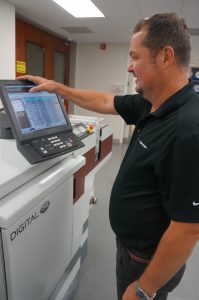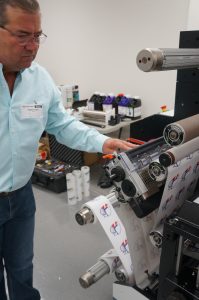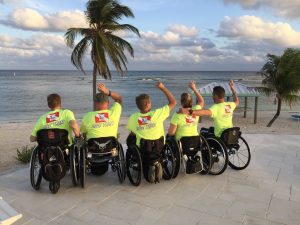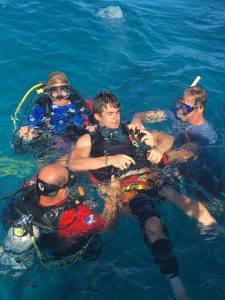A Life-Affirming Label
FTA Members Use Digital Printing to Produce Job for Nonprofit
We talk a lot about packaging that grabs consumer attention, has shelf appeal and, at the end of the day, is designed to generate sales. But there are use cases which are not so focused on an exchange of money and instead on alerting passersby to something which intends to give rather than take; less capitalistic and more altruistic.
It was one such application for which Wade Fouts, VP of manufacturing at Wilson Manufacturing Co, came to fellow FTA member Mark Andy Inc looking for some help.
A Job Worth Doing
In discussions with the press manufacturer’s Digital One team, Wade asked if Mark Andy could provide prepress support on labels destined for oxygen tanks belonging to LifeWaters, a nonprofit founded by Wilson’s CEO Matthew Wilson and SCI Scuba Instructor Charlie Wright that provides veterans, civilians and first responders with adaptive scuba diving and snorkeling for them and their families.
The design—which combines the letters “L” and “W” to create the image of a wheelchair, onto which an oxygen tank is affixed—came from another LifeWaters volunteer and, Matt says, was instantly liked by everyone involved. It was when Wade brought that design to Mark Andy that the company had a thought.
“The printer Wade was working with shared the image resolution, and it was too low,” recalls Aaron St. John, print and graphics technician at Mark Andy. “Upon reviewing the artwork, it dawned on me that we should just run the labels on the Digital One.”
 When it came time to print the labels, two separate jobs were run. Each consisted of 3,000 examples, the only difference being the label’s size. A white, biaxially oriented polypropylene (BOPP) film—Fasson 78333—was used. Given its use, one of the primary concerns factored into the label’s printing was its ability to withstand exposure to saltwater. Aaron explains the Digital One’s Marine Immersion BS (British Standard) 5609 certification made the press an ideal candidate for job.
When it came time to print the labels, two separate jobs were run. Each consisted of 3,000 examples, the only difference being the label’s size. A white, biaxially oriented polypropylene (BOPP) film—Fasson 78333—was used. Given its use, one of the primary concerns factored into the label’s printing was its ability to withstand exposure to saltwater. Aaron explains the Digital One’s Marine Immersion BS (British Standard) 5609 certification made the press an ideal candidate for job.
Mark Andy Senior Applications Engineer Paul Higgins operates the company’s Digital One digital press while the LifeWaters label is printed. Source FTA
Diving Into Digital
“One of the main reasons we chose to run the job on Digital One is because it retains a BS 5609 certification, which was important because the labels will be applied to oxygen tanks,” Aaron says, but he adds that was not the only driving factor. The short-run nature of the job, minimal waste and ease of setup on the digital press all favored its use over a conventional flexo machine. Those selling points have been listed out more and more in recent history as reasons to adopt digital printing for the jobs which are most suited to them, not to the detriment of flexography but to allow the process to handle work it can do better and for less.

“This job could have been produced flexo, but for an application like this it would have been suboptimal,” he admits. “Given the low production volume, we would’ve incurred much more cost and the job would’ve taken a lot more time.”
Aaron believes the market for flexographically printed packaging isn’t going anywhere, especially for its bread and butter long-run work. For labels and the rest of the narrow web market, he predicts hybrid printing—“a combination of the two complementary processes” which enables converters to produce short-run work profitably, while still reaping the benefits of inline flexo decoration—as the path forward.
Photo Caption: Wilson Manufacturing’s Wade Fouts inspects the job as it runs. Source: FTA
From Dipping a Toe, To Jumping In
A look in the other direction provides insight into how LifeWaters came to be.

Photo Caption: “The water frees us from the chair,” say LifeWaters’ adaptive divers. Source: LifeWaters
“Water has been a huge influence on my entire life, with my background as a competitive swimmer as young as 5 years old, through Division 1 collegiate swimming, to coaching casual swimmers, to coaching Olympic trials-level swimmers,” says Charlie.
In 1999, while finishing both his degree at Arizona State University and scuba instructor certification, he was introduced to the Handicap Scuba Association and the idea for LifeWaters was born. “This program, from the beginning, was designed to help those who were physically or mentally challenged to positively impact not only their lives but also their family members,” he says.
Since its inception, LifeWaters has used scuba diving “to provide the opportunity to learn new life skills and offer endless possibilities” to individuals who have disabilities that are either congenital or stem from a traumatic injury, explains Matt. He says it does this through camaraderie, training and certification.
 The nonprofit has also taken veterans, civilians and first responders with mobility challenges or post-traumatic stress disorder (PTSD) on scuba diving and snorkeling trips to the Georgia Aquarium, Cozumel, Cayman Brac and Florida. It strives to give these opportunities to families by offering free instruction and certification as often as possible, and low-cost training for individuals who want to volunteer as “dive buddies.”
The nonprofit has also taken veterans, civilians and first responders with mobility challenges or post-traumatic stress disorder (PTSD) on scuba diving and snorkeling trips to the Georgia Aquarium, Cozumel, Cayman Brac and Florida. It strives to give these opportunities to families by offering free instruction and certification as often as possible, and low-cost training for individuals who want to volunteer as “dive buddies.”
“LifeWaters has a unique perspective on disabilities. They put the primary focus on what I ‘can’ do, not what I can’t do,” says Kevin, one of the program’s adaptive divers. “It is a culture and a family. Everyone genuinely cares about everyone. For any individual with a disability who is thinking, ‘I wonder if I can do that?’ the answer is very simple. Reach out to LifeWaters and ask.”
Hack Albertson, also a certified adaptive diver, the national VP of Paralyzed Veterans of America and a member of LifeWaters’ executive board, says he cannot thank the group enough. “No words describe how much freedom there is below the waves and swimming wherever I want to go—Free for an hour from my wheeled prison.”
*Article originally written for use in the March 2018 edition of FLEXO magazine. You can find an online version of the article here.
About the Author
Brad Pareso is the content manager and digital strategist at Flexographic Technical Association (FTA). To learn more about FTA, visit www.flexography.org.
